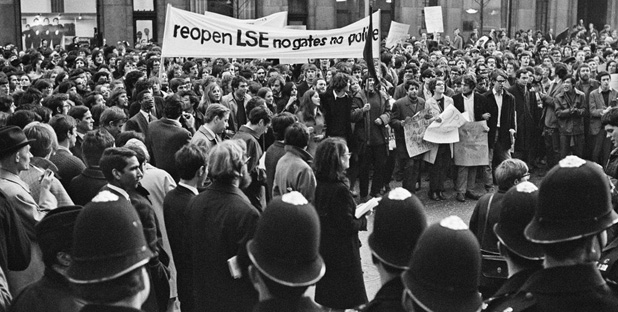STUDENT activism was rife in the late 1960s and nowhere more so than at the London School of Economics, where the Students Union was regarded as the most politically active in Britain.
Student unrest wasn’t confined to Britain in the sixties; it was widespread in the USA, especially in anti-Vietnam War protests, and in parts of Europe. But students at the LSE were known for campaigning and holding demonstrations, some of which turned violent and were dubbed “student riots” in the tabloid press.
 The LSE was in the news 50 years ago today, when it was shut down following a violent protest by students angry at the installation of steel security gates on their central London campus. It was the latest in a series of confrontations between politically active students and the LSE’s management since its appointment two years previously of Dr Walter Adams as the school’s director.
The LSE was in the news 50 years ago today, when it was shut down following a violent protest by students angry at the installation of steel security gates on their central London campus. It was the latest in a series of confrontations between politically active students and the LSE’s management since its appointment two years previously of Dr Walter Adams as the school’s director.
They objected to Dr Adams’ appointment because he had previously been in Rhodesia and was accused of complicity in its white minority rule – something which the Students’ Union was strongly opposed to. It led to a number of protests, sit-ins and building occupations, including one in which a university porter died of a heart attack. Whenever the instigators were suspended, it just sparked more demonstrations and sit-ins in support of them.
Determined to make the LSE buildings more resistant to invasion by protesting students, the school’s directors installed several sets of security gates across its Aldwych campus, which could be locked at particular times. This angered students who saw it as an attack on their right to stage peaceful protests and claimed the gates made their university look like a concentration camp. Some of the academic staff at LSE agreed and took the students’ side.
Dr Adams said the gates would allow certain buildings to be closed off during protests, while allowing other parts, such as the Student Union premises, to remain open. He said they were necessary due to the disruption caused and, on some occasions, damage done during previous demonstrations. As students gathered to voice their anger, a meeting was arranged between LSE staff and Student Union reps to discuss the gates.
First, a Student Union meeting was called to formulate its approach to the talks. Union president Francis Keohane put forward a motion that the gates should be removed through negotiation with the LSE, but his members were having none of it. The motion was defeated and within half-an-hour students were physically tearing down the seven sets of gates using crowbars, pickaxes, sledgehammers and anything else they could find.
When police were called in, they arrested 25 students and took them to Bow Street Police Station. News of the arrests led to more students gathering and marching in a column nine abreast to the police station to demand the release of their colleagues. Fearing the situation was getting out of hand, the Union president announced his immediate resignation, saying he could not defend the law-breaking direct action when the LSE had been open to negotiation. The union’s treasurer, Roger Mountford, also resigned.
With the LSE shut down “until order could be restored”, the student demonstrations continued. A few days later some of the ‘rebel students’ occupied a building belonging to the nearby University of London, declaring it the “LSE in exile” and putting up posters on the doors and walls which read; “Occupied for Student Action”. Any hopes for a show of solidarity from University of London students were dashed when several of them helped police turf out the intruders so they could get on with their medical studies.
As the protests slowly fizzled out, the LSE re-opened after three weeks, with lectures and tutorials resumed. Legal action was brought against 13 people said to be ringleaders of the disturbances, including three staff members. Several students were suspended for a month and only allowed to return on the promise that they wouldn’t interfere with the LSE’s management or damage its property again. Two of the three staff members were subsequently sacked.
